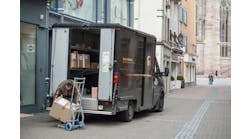If Jamaica’s Minister of Industry, Investment and Commerce has his way, his country will take the logistic industry by storm and become the fourth node in the global logistic structure.
And as always, location is the key.
“Sitting at the doorway to the newly expanded Panama canal, Jamaica wants to position itself to join Rotterdam, Dubai and Singapore as the fourth node in the international logistics chain,” explains. G. Anthony Hylton, MP, Minister of Industry, Investment and Commerce.
Hylton points out that Jamaica compares favorably with the existing three nodes as it sits astride the trade routes in the Windward Passage and has access to the 800 million-person market of North, Central and South America.
Seeing this opportunity years ago, the government got to work addressing the issues of both the physical infrastructure and the other components necessary to reach this goal.
Last year the country got one of the green lights it needed to move forward. In the Logistic Performance Index, which measures factors such as ease of dealing with customs, infrastructure, international shipments, logistics and tracking, and tracing containers, Jamaica jumped to 70 from 124 in 2012.
Additional green lights have come from significant movement in other rankings including The World Bank’s Doing Business Ranking where Jamaica moved up 27 places, from 85 to 58 and The Global Competitiveness Index, which saw the country rank 86 out of 144 countries in 2014, compare to 94 out of 148 countries in 2013.
From a financial perspective, the country, which has a very large debt to GDP ratio, has moved in a positive direction. Speaking at the recent Investor Forum 2015, Portia Simpson Miller Prime Minister of Jamaica reported that, “Jamaica continues to perform strongly and remains on track with our targets under the four-year Extended Fund Facility with the International Monetary Fund.”
In May of 2013 Jamaica signed a four year Extended Fund Facility with the International Monetary Fund (IMF) and received a support package of $932 million to facilitate economic reform to stabilize the economy and reduce debt. In support of the IMF package, the World Bank Group and the Inter-American Development Bank each allocated $510 million to Jamaica for the same period.
The economic reforms are working as evidenced by Standards and Poor’s revision of Jamaica's long-term sovereign outlook upwards to positive from stable. Fitch upgraded Jamaica’s long term foreign currency and local currency Issuer Default Ratings to ‘B-’ from CCC and Moody’s upgraded the outlook on Jamaica's government bond rating to Caa3, positive from stable.
These favorable rankings and financial improvements are essential in order for the country to move forward with its Global Logistics Hub Initiative which is the cornerstone of the country’s future economic development. The Hub will involve multiple modalities through the integration of world-class seaports (handling containers, dry bulk and liquid bulk commodities), airports, special economic zones, free zones, logistics parks, logistics centers, integrated intermodal transport capabilities, supporting infrastructure, telecommunications and trade facilitation mechanisms.
Public Private Partnerships Key to Funding
Given the scope of the Hub, which Hylton estimates at between $8-10 billion, the government is turning to public-private partnerships as the source of funding for these projects. In fact the Investment Forum 2015, held in March, was the government’s opportunity to present a number of investment opportunities to the global market.
The major projects up for funding include the expansion of the Port of Kingston; construction of a dry dock at Jackson Bay, Clarendon, installation of bunkering facilities at Cow Bay, St Thomas; construction of cargo and maintenance, repair and operations facility at Vernamfield in Clarendon; and the development of an economic zone at Caymanas with direct road link to the Port of Kingston.
Let’s take a closer look at some of the projects.
The Kingston Container Terminal is the one of the largest transshipment ports in the Central American and Carribean region, with a capacity of 2.8 million TEUs and has the ability to accommodate vessels carrying up to 10,000 TEUs. The goal was to grant a long-term concession to a private operator so the port can capitalize on the expansion of the Panama Canal.
In April of 2015 the government signed a concession agreement with Terminal Link, which is jointly owned by CMA/CGM and China Merchant Marine. The French company, which is the world's third largest shipping company with 445 vessels serving more than 100 ports globally, will invest $600 million to upgrade and expand the terminal.
The work will be done in two phases. The first phase will reinforce 120 meters of the berth to meet Euro codes 2004 and in the second phase 800 meters of the berth will be reinforced to a depth of 15.5 meters.
A newly formed company, Kingston Freeport Terminal Ltd., will operate the terminal for 30 years and then transfer ownership back to Jamaica. Port Authority of Jamaica President Professor Gordon Shirley told the Jamaican Gleaner that the partnership was especially strong as Terminal Link has very aggressive growth plans which would include attracting investment, light industry and processing services. Additionally the group will invest 130 million to dredge Kingston Harbour, which is the seventh largest natural harbor in the world.
“The aim is to integrate the port with warehouse, distribution, assembly and manufacturing facilities to maximize supply chain efficiencies, minimize logistics costs between “origin and destination” and create additional value,“ Shirley said at the Investment Forum 2015.
In addition to improved sea transport, improved air transport is an integral part of the Hub. The privatization of Norman Manley International Airport, the second largest in the country, was one of the proffered investments available at the Investment Forum 2015. And last month a consortium of Grupo Puntacana, Jamaica Producers Group and the GB Group was selected as one of the prequalified firms to pass on to the second stage in the privatization process.
The success of the privatization in 2003 of the Sangster International Airport in Montego Bay is the model for privatizing the Normal Manley airport said Hylton. Sangster is operated by MBJ Airports Ltd. under a 30-year concession granted by the government.
Another air hub under development is the Vernamfield property, which be transformed into an international air and sea cargo hub, complete with airport maintenance facility, runway, terminal and warehouses. Hylton said the property will be able to “facilitate long-haul cargo and passenger flights, as well as a maintenance, repair and overhaul (MRO) facility.”
The property will be linked to the Kingston Port through Highway 2000 and the “the railway line which originates near the ports and passes through the Caymanas Economic Zone...will be rehabilitated to allow for the transport of goods between these two points,” he said. The site will also host an aviation training school.
The proposed business structure for the development is a joint venture between the Port Authority of Jamaica and a private developer, with various strategic investors as developers and or operators.
The total development project is estimated at $1 billion to design and construct two parallel 11,000 foot runways and taxi ways. The development includes the construction of Category Five hurricane-proof aircraft hangers, which will include offices and warehousing.
Economic Zones Drive Growth
All of the logistic upgrades that are under development are to support increased commerce to ensure economic growth. Globally a common tool to attract investment is through the use of economic zones and Jamaica is no different. The proposed Caymanas Economic Zone will consist of an industrial zone, a technology park and a facility providing renewable energy to these ventures. A feasibility study for the first large scale integrated industrial zone in Jamaica, received $30 million in funding for 2015-2016. Hylton sees the zone as a way to develop industrial clusters, attract new technology and also to modernize management practices.
Within the zone are several product-and-service differentiated zones: Business Incubators Industrial Zone, Recreational Parks, Utilities/Infrastructure Warehousing. The Zone will also include numerous support services including banking, training, retail, maintenance, and health, air, road rail and sea access to the facility.
Phase one of the development will be an Information and Communications Technology (ICT) Park. Which will house facilities for Software Development, Telecommunications/Co-Location sites, Bio-Technology, Business Process Outsourcing (BPO), IT/Security Consultancy and Network Operations Centre. The projection is that 21,000 jobs will be created. Total investment for completion of the buildings is estimated at $90 million.
Even as these positive steps are being undertaken, the country has a number of challenges to its growth plans. One of the largest issues is with regard to customs. To address this there is a new Automated System for Customs Data (ASYCUDA) which will modernize the customs administration. Full deployment is expected to occur in April 2016. Additionally implementation of an e-Trade system will allow importers and exporters to lodge documents electronically and facilitate the exchange of information between government agencies and traders.
With the country working on the customs systems and other improvements to attract more foreign direct investment to fund the Hub, the recent announcement of a MOU with German engineering company Krauck Systems and U.S.-based financier Anchor Financial Group for a $5 billion investment in the hub was welcome news. Hylton said Krauck Systems has displayed interest in the logistics hub in Jamaica for the last year and half and is interested in a cluster of projects such as Vernamfield, Caymanas Economic Zone, a dry dock facility, and a commodity port. Currently, details of the agreement are being reviewed.
To Hylton this investment signals that the global community sees opportunity in his country. ““We continue to put the necessary measures in place so that investors will have confidence in our economy,” he said. “We are confident in the future of the Jamaican economy,”




